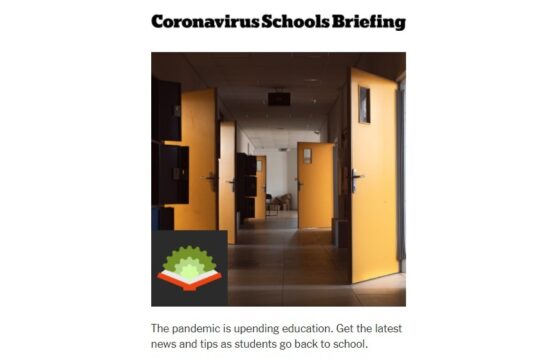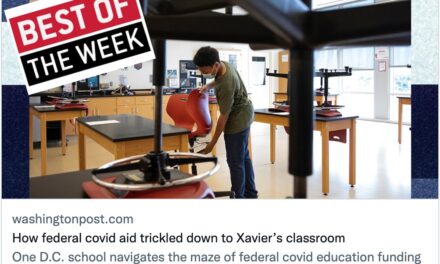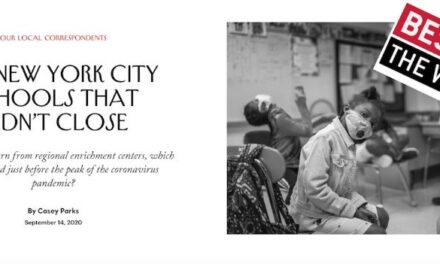Just two and a half months old, the Coronavirus Schools Briefing newsletter is playing an outsized role.
By Alexander Russo
The fall’s most valuable new piece of education journalism might be the New York Times schools briefing newsletter.
Yes, an email newsletter, one of the most ubiquitous and slight forms of modern journalism.
Launched halfway through August, the effort could easily have gotten swallowed up in the glut of back-to-school stories and many other outlets’ efforts to own the story. It could easily have outlived its usefulness and seemed unneeded or unfocused, as so many newsletters do.
Almost immediately, however, the decision to launch the newsletter at this historic moment seemed inspired.
I’m sure I’m not the only person who wished I’d thought of it.
It features an appealing mix of items from the Times’ COVID-19 coverage, original reporting, and curated stories from other outlets. It does an impressive job helping readers make sense of what’s going on in a complicated, fast-moving environment.
Most of all, it provides a calm, steady look at an extremely intense issue and a particularly challenging story to cover.
“We won’t fill you with more panic, rage or despair,” tweeted Adam Pasick, one of the two Times journalists behind the effort. “We’ll go beyond alarming headlines to help you make informed decisions in difficult circumstances.”
By and large, the newsletter has kept to that promise. It helps readers understand what’s going on. It gives meaning to the firehose of information that comes through news accounts and social media every day. It slows things down just a little bit, in a good way.
Crossed fingers it will continue to do so in the coming months, improving as it goes.
“We won’t fill you with more panic, rage or despair. We’ll go beyond alarming headlines to help you make informed decisions in difficult circumstances.” – Adam Pasick
Formally called the Coronavirus Schools Briefing, the newsletter is one of the latest in a slew of newsletters produced by the Times, including a Parenting newsletter and one tasked with giving readers a daily update on the COVID-19 pandemic.
The Times newsletters are all pretty well done, mixing carefully selected content with links to additional resources. But right off the bat, I could tell that this was an especially good addition that, if well-executed, could be enormously successful.
A highly curated newsletter requires smart choices but doesn’t necessarily require a lot of additional reporting time. As a pop-up newsletter, it requires no long-term commitment from the paper.
There has been a desperate need to help people keep up with the fast-changing reopening story, without overwhelming them.
This newsletter usually features three main sections: a featured story, often taken from the Times’ own pages, with lots of links for additional reading; a second story, and then a roundup of K-12 and postsecondary stories from other outlets.
The national overview is much needed, and the Monday-Wednesday-Friday production schedule is enough but not too much. The inclusion of both K-12 and higher education gives it some breadth, but not too much to weigh it down.
The newsletter also manages to capture the realities of reopening more carefully than many others. For example, the September 11 edition focused on a teacher’s death — a common topic of coverage — but it contextualized the tragedy differently, noting that the pandemic is also “killing hundreds of Americans every day, from many occupations and backgrounds.”
And, to be honest, I find it welcome because it reflects my own particular views about the school reopening issue, which are that the dangers of bringing students back to campus should be carefully weighed against the risks of staying remote, and that amplifying readers’ fears is unnecessary and ultimately alienating.
It featured a story about Rhode Island’s remarkable effort to reopen schools in person, something few New England states have managed to pull off despite relatively low community infection rates. It highlighted how one district in California managed to return to in-person education, a tentative success story that remains under-reported. And it’s been among the few places where journalists are educating readers about how COVID cases alone aren’t in and of themselves a reason to panic.
Sign up here for our free newsletter featuring the week’s best education news & newsroom comings and goings.

Pasick (left), and Nierenberg
Key to the success of the effort has been the pair journalists who are most closely involved.
As a veteran newsletter producer, Pasick certainly knows how to construct a product that readers will embrace. As a parent, he has firsthand experience in the many challenges of working from home, supervising remote learning, and making tough decisions about in-person learning. And he has the wisdom to let his writing partner Amelia Nierenberg explore some of the most interesting aspects of the story, including moments in which she challenges education reporting produced by her colleagues at the paper and elsewhere. Or at least, that’s how I imagine it works; they declined to be interviewed.
Nierenberg’s work seems key to the success of the effort. A 2018 college graduate and recent alum of the highly competitive New York Times fellowship, Nierenberg is not entirely new to covering education. Her first journalism job was a metro reporting internship at the Boston Globe, during which she interviewed nearly 80 former valedictorians for what became the January 2019 Valedictorians Project.
“Amelia just did incredible work,” recalled the Boston Globe’s Scott Helman, director of audio and emerging media. Tasked with locating hard-to-find former Boston Public Schools students, Nierenberg “killed it,” he told me in a recent phone interview, showing up regularly with new information about graduates that nobody had been able to find. “It was really quite a feat.” Throughout her reporting, she “saw the larger value” of the overall project, according to Helman.
By many accounts, the quality of her work on the newsletter has been just as strong.
“She’s a delight, professional and thoughtful. She effectively draws out the major themes, and represents the major issues with integrity,” said Megan Ranney, an emergency room doctor and Brown University public health researcher who’s frequently interviewed by the press. “With Amelia, it feels like she’s trying to go deeper, to connect the dots that others may not have done.”
To learn more about how the media covers education, follow The Grade on Twitter and Facebook.

A recent edition of the newsletter. You can sign up here.
In some ways, the newsletter functions as a column, giving readers an overview that they might not get from individual stories. In other ways, the newsletter fills in with spot coverage that the paper might not otherwise get.
Its presence is especially welcome at a rough time for education journalism at the Times, during which key reporters have been out of pocket and the coverage has at times seemed uncoordinated and tending toward alarmist.
And it appears to have been a success in terms of audience metrics. While the Times won’t reveal any specifics, remarks attributed to Pasick state, “We’ve seen an engaged and fast-growing audience come to rely on the newsletter.”
Of course, the newsletter sometimes falls into bad habits, focusing on alarming-seeming COVID-19 case numbers or privileging middle-class perspectives over those of working-class families.
In a perfect world, it would focus more of its attention on the impact of the shutdown on the most vulnerable students, whose experiences are still woefully under-reported. And it would make a concerted effort at highlighting standout stories produced by education journalists of color, whose work is so essential.
But a newsletter can only do so much in its first two and a half months, and – so far at least – this one has made a small but important contribution during a very difficult time. Let’s hope it continues to play a constructive role and to improve in the coming months.
Related coverage:
Journalists’ strategies for covering the school reopening story
Jacqueline Rabe Thomas: A veteran reporter finds success and satisfaction staying local
How media coverage turned vulnerable kids into an invisible threat
What makes New York Times education reporter Erica Green so good?
ABOUT THE AUTHOR

Alexander Russo
Alexander Russo is founder and editor of The Grade, an award-winning effort to help improve media coverage of education issues. He’s also a Spencer Education Journalism Fellowship winner and a book author. You can reach him at @alexanderrusso.
Visit their website at: https://the-grade.org/














